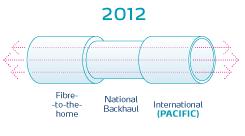Pipe dream or economy booster?
 The news yesterday that a group of wealthy businessmen including Warehouse founder Stephen Tindall and Trade Me founder Sam Morgan are leading a $900 million bid to build a 13,000km fibre optic cable between Australia, New Zealand and the US has created a lot of buzz.
The news yesterday that a group of wealthy businessmen including Warehouse founder Stephen Tindall and Trade Me founder Sam Morgan are leading a $900 million bid to build a 13,000km fibre optic cable between Australia, New Zealand and the US has created a lot of buzz.
The prospect of an internet without data download caps is a tantalizing one – New Zealand is one of the few OECD countries where there are limits placed on the amount of data you can transfer over your broadband connection each month.
Morgan and company suggest this is creating a digital divide between New Zealand and the rest of the world. Are they right? Well, it is hard to compare New Zealand to countries such as the US and Japan which are relatively well developed with uncapped broadband services. But innovation in rich content and real-time streaming services in those countries is certainly much farther ahead than in New Zealand.
The SMC wrapped up comment from the science sector on the implications for a second high-capacity cable linking New Zealand and the US and the reaction has been largely positive.
As NZICT chief executive Brett Riley pointed out, more (and cheaper) capacity is essential for a project like the Square Kilometre Array in which New Zealand hopes to be involved. It could also help lower international connection costs for the KAREN (Kiwi Advanced Research and Education) network: as REANNZ chief executive Donald Clark said:
“More competition on bandwidth supply from Australasia to the rest of the world will ultimately result in more international research and innovation collaboration which in turn will boost New Zealand’s economy”.
Scibloggers on the Pacific Fibre plans:
Grant Jacobs: High-speed international connection? Yes please
John Nixon: The undersea connection
Peter Griffin: Bigger, faster, more productive
Answers to climate change fatigue
Scientists at the STS (Science, technology and Society) Network workshop held in Wellington this week took part in a Science Media Centre briefing on “risk fatigue” and the disconnect between the dire scenarios of climate scientists and the willingness of society to act to avoid them.
Emeritus Professor Ian Lowe of Griffith University and ESR’s Dr Karen Cronin suggest that science needs to change to better address the social implications of climate change. A more integrated approach between biophysical science and social science is what they are calling for, as well as a more detailed look at scenarios for climate change mitigation and adaptation in New Zealand and Australia beyond 2025.
You can listen to the podcast of the briefing here.
Are you on Twitter? Let us know…
 From the Chilean earthquake to the moa DNA breakthrough, science news is increasingly spreading through the social network Twitter as people re-tweet stories of interest and in some cases, even break news themselves.
From the Chilean earthquake to the moa DNA breakthrough, science news is increasingly spreading through the social network Twitter as people re-tweet stories of interest and in some cases, even break news themselves.
We are on Twitter – twitter.com/smcnz and twitter.com/sciblogsnz – and we are in the process of generating a science media list of science journalists on Twitter. Sign up to follow us on Twitter if you want to be added to the list. If you are looking for scientists and science writers to follow on Twitter here are some of our favourites: @boraz @carlzimmer @bengoldacre @davemunger and @catherineq (a Kiwi astrophysicist and NASA fanatic at the University of North Carolina!).
Perhaps if you focused on answering questions on science and not promoting alarmist propaganda then the public might listen.
As it is, the public are tired of hearing about climate change because the climate change industry has shot itself in the foot by spreading lies and misinformation to the public for years.
Climate-gate and hockey sticks have sealed the fate.
It’s such a shame about the planet.